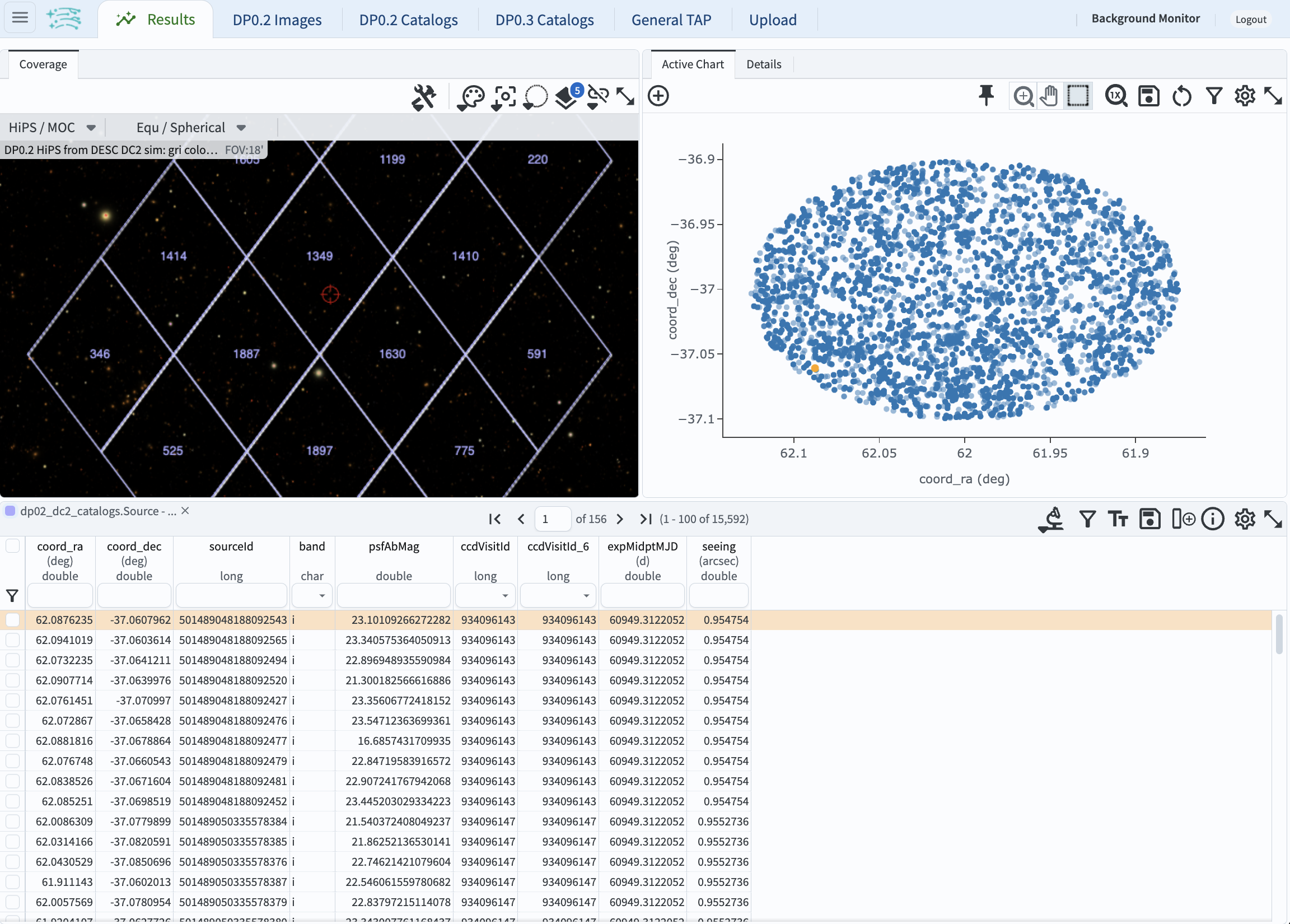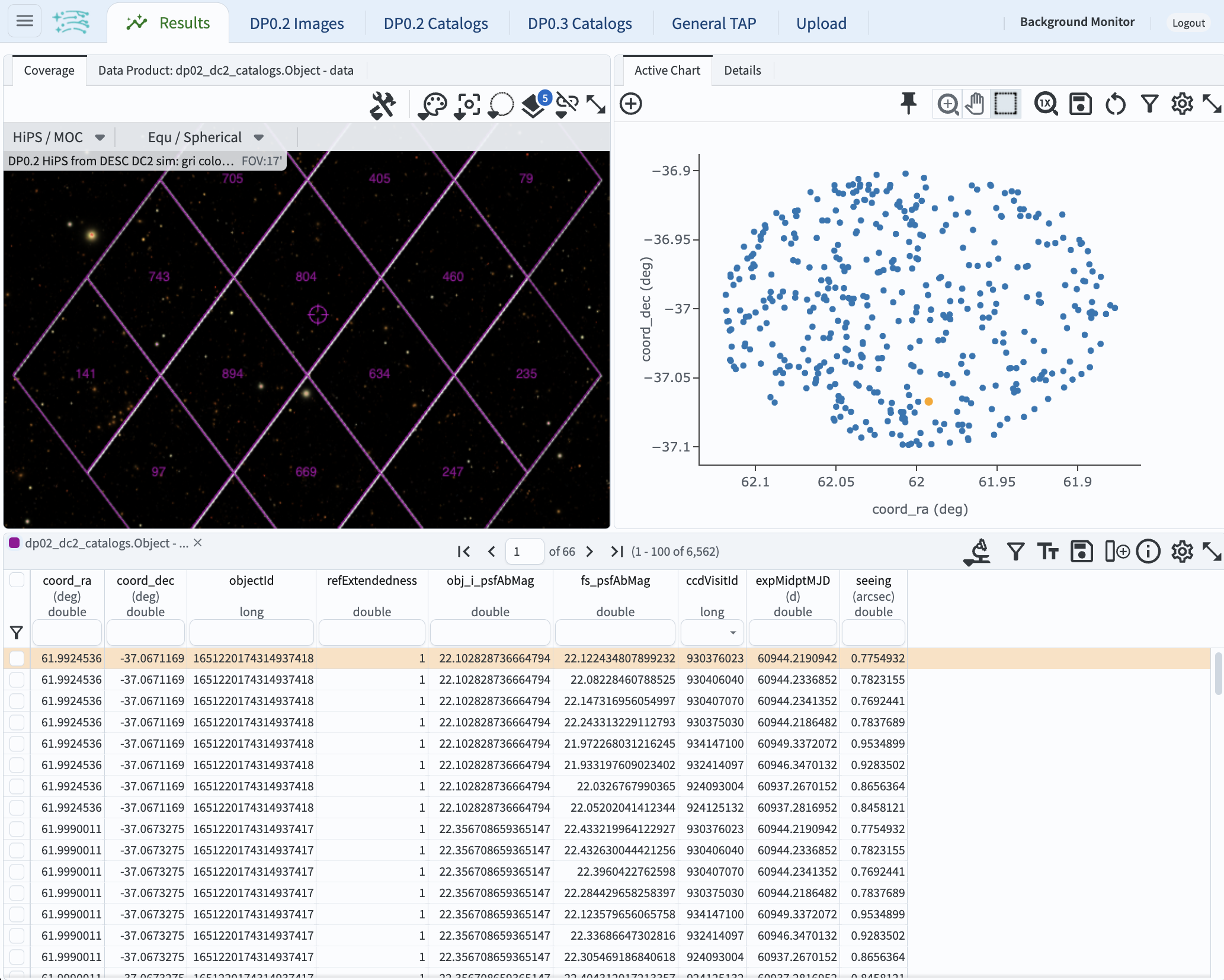06. How to join tables with ADQL¶
RSP Aspect: Portal
Contact authors: Greg Madejski and Melissa Graham
Last verified to run: 2025-02-04
Targeted learning level: intermediate
Introduction: This tutorial demonstrates how to join tables from a given catalog and retrieve results with ADQL.
Warning! Not all tables can be joined. Two tables must have a column in common in order to be joined.
1. Go to the DP0.2 catalog ADQL interface. Navigate to the Portal’s DP0.2 Catalogs tab and switch to the ADQL interface.
2. The ADQL components of a JOIN…ON statment. The generic example below illustrates a common join scenario. Four columns (“ra”, “dec”, “colA”, and “colB”) are selected from “table1”, for objects where their coordinates are within 0.1 degrees of RA=62 deg, Dec=-37 deg. The results from “table1” are joined with “table2” on their matching column, “colID”. Two columns are selected from “table2” (“colX” and “colY”).
SELECT tab1.ra, tab1.dec, tab1.colA, tab1.colB, tab2.colX, tab2.colY
FROM table1 AS tab1
JOIN table2 AS tab2
ON tab1.colID = tab2.colID
WHERE CONTAINS(POINT('ICRS', tab1.ra, tab1.dec),
CIRCLE('ICRS', 62.0, -37, 0.1)) = 1
**The above cannot be executed and is a generic demonstration only.**
3. Execute a two-table join.
The Source table (detections in individual processed visit images) can be joined with the
CcdVisit table (metadata about individual visits) using a shared column, ccdVisitId,
which uniquely identifies an LSST visit.
Constraints can be applied on columns from either or both tables.
Spatial constraints are applied to the FROM table, not the JOIN table.
SELECT src.coord_ra, src.coord_dec, src.sourceId, src.band,
scisql_nanojanskyToAbMag(src.psfFlux) AS psfAbMag,
src.ccdVisitId, cv.ccdVisitId,
cv.expMidptMJD, cv.seeing
FROM dp02_dc2_catalogs.Source AS src
JOIN dp02_dc2_catalogs.CcdVisit AS cv
ON src.ccdVisitId = cv.ccdVisitId
WHERE CONTAINS(POINT('ICRS', src.coord_ra, src.coord_dec),
CIRCLE('ICRS', 62.0, -37, 0.1)) = 1
AND cv.expMidptMJD > 60925 AND cv.expMidptMJD < 60955
AND src.band = 'i'
4. Review the two-table join results.
Notice that this join is not one-to-one: there are multiple individual sources returned that are matched to the same visit.
In other words, there are multiple rows from the Source table joined with a given row from the CcdVisit table.

Figure 1: The Portal Results tab with a default layout for the data returned from the two-table join query.¶
5. Execute a three-table join.
The Object table (photometry in deeply coadded images) can be joined with the
ForcedSource table (photometry in individual processed visit images) using their shared objectId column.
The ForcedSource table can be joined with the CcdVisit table using ccdVisitId.
Constraints can be applied on columns from any or all tables.
SELECT obj.coord_ra, obj.coord_dec, obj.objectId, obj.refExtendedness,
scisql_nanojanskyToAbMag(i_psfFlux) AS obj_i_psfAbMag,
scisql_nanojanskyToAbMag(fs.psfFlux) AS fs_psfAbMag,
cv.ccdVisitId, cv.expMidptMJD, cv.seeing
FROM dp02_dc2_catalogs.Object AS obj
JOIN dp02_dc2_catalogs.ForcedSource AS fs
ON obj.objectId = fs.objectId
JOIN dp02_dc2_catalogs.CcdVisit AS cv
ON fs.ccdVisitId = cv.ccdVisitId
WHERE CONTAINS(POINT('ICRS', obj.coord_ra, obj.coord_dec),
CIRCLE('ICRS', 62.0, -37, 0.1)) = 1
AND obj.refExtendedness = 1
AND obj.i_psfFlux > 3600
AND cv.expMidptMJD > 60925 AND cv.expMidptMJD < 60955
AND fs.band = 'i'
6. Review the three-table join results.
The join of Object to ForcedSource is one-to-many, and the join of ForcedSource to CcdVisit is many-to-one.

Figure 2: The Portal Results tab with a default layout for the data returned from the three-table join query.¶
7. Find more join examples. Visit the ADQL Recipes page for more examples of table joins. Visit the DP0.2 schema browser to see which tables have columns in common.
Return to the list of DP0.2 Portal tutorials.